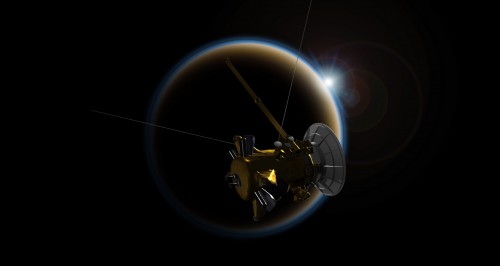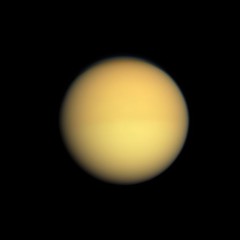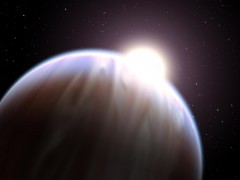
Saturn’s moon Titan is one of the murkiest places in the Solar System; its thick smog-like hydrocarbon haze in the upper atmosphere shrouds the entire moon, much like Venus’ perpetual cloud cover. Titan’s surface is completely hidden by this orange-ish haze, making it look rather bland and uninteresting. This unique environment may provide valuable clues to the nature of atmospheres on distant exoplanets, however, according to new findings from scientists with the Cassini mission.
Even though Titan is a moon and not a planet, it is the most planet-like moon in the Solar System with a dense nitrogen and methane atmosphere, and rain, rivers, and lakes composed of liquid methane/ethane. Its planet-like qualities make it an ideal case study for those exoplanets in other solar systems which may have similar conditions.
The scientists have developed a new technique, using Titan as a model for a possible exoplanet atmosphere, to understand how the haze in such an atmosphere could affect astronomers’ ability to study it. As Tyler Robinson, a NASA Postdoctoral Research Fellow at NASA’s Ames Research Center notes, “It turns out there’s a lot you can learn from looking at a sunset.”
The new research was published on May 26 in the Proceedings of the National Academy of Sciences.

So how can learning about Titan’s atmosphere help to understand the atmospheres of planets so much farther away? The answer is to study the spectra; light can be divided into its individual colors, or spectra, which can reveal information about the object the light is coming from (you can see spectra when using a prism). This includes sunsets and even planets and stars. By examining the spectra of distant exoplanets, astronomers can find out what the properties of the planets are, such as temperature, composition, and structure of the atmospheres. The details we currently know about Titan’s atmosphere could be compared to those of exoplanets being studied. With so many exoplanets now being discovered, it is likely that some of them will possess atmospheres similar in some ways to Titan’s, or certainly gas giant-type planets which are also enveloped in thick, turbulent atmospheres.
How does it work? When an exoplanet transits in front of its star, as seen from Earth, the light from the planet’s host star passes through the planet’s atmosphere. The subtle changes that causes can then be detected in the spectra for that planet.

Titan is ideal for observing similar transits, where the Cassini spacecraft has studied its atmosphere in much the same way, by looking at Titanian sunsets. For the study, four observations of Titan’s atmosphere by Cassini were used, from between 2006 and 2011. It’s a good opportunity to see how Titan’s hazes affect the observations; similar high-altitude hazes in exoplanetary atmospheres could complicate an analysis of the atmosphere as a whole by “masking” the atmosphere below the haze.
Mark Marley, a co-author of the study at NASA Ames, notes: “People had dreamed up rules for how planets would behave when seen in transit, but Titan didn’t get the memo. It looks nothing like some of the previous suggestions, and it’s because of the haze.”
“Previously, it was unclear exactly how hazes were affecting observations of transiting exoplanets,” adds Robinson. “So we turned to Titan, a hazy world in our own solar system that has been extensively studied by Cassini.”
Exoplanets are so far away that being able to study them or their atmospheres at all is nothing short of incredible. But thanks to worlds like Titan in our own backyard, astronomers are now becoming able to do just that. “It’s rewarding to see that Cassini’s study of the solar system is helping us to better understand other solar systems as well,” said Curt Niebur, Cassini program scientist at NASA Headquarters in Washington.
Of course, one of the most exciting prospects is being able to detect possible biosignatures in alien atmospheres. Titan may be of help with this also, since its atmosphere and surface are rich in complex organic molecules, which life is made of. It is even possible that there may be some form of primitive life on Titan, in its lakes and seas or even in the water ocean thought to exist below the surface. At the very least, Titan can provide clues to how life developed on Earth, and now maybe even on other far-off worlds.
Want to keep up-to-date with all things space? Be sure to “Like” AmericaSpace on Facebook and follow us on Twitter:@AmericaSpace



